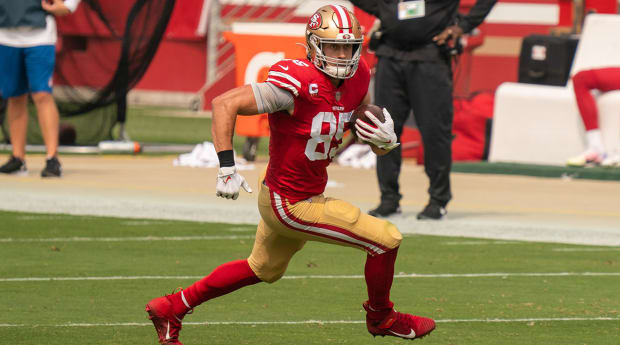Over the last two-plus seasons, 49ers TE George Kittle has established himself as not just one of the top tight ends in football right now, but a player with the potential to go down one of the best the NFL has ever seen. Given his unique talents, and the changing nature of the position, it’s hard to compare him to just one predecessor.
Welcome to Shades Of, where SI experts discuss young, emerging stars across all sports in the context of which current veterans or retired athletes they draw comparisons to, based on everything from stats to stature, style and more.
Who does George Kittle remind you of?
Over the last two-plus seasons, Kittle has established himself as not just one of the top tight ends in football right now, but a player with the potential to go down one of the best the NFL has ever seen.
Given his unique skill set, it’s hard to compare him to just one player. Kittle put himself on the map in 2018, his first full season as a starter, when he set a tight end record with 1,337 yards. Yes, the NFL has gotten more pass-happy, and records seem to fall every year, but it’s still more than all-timers like Rob Gronkowski, Tony Gonzalez or Antonio Gates ever had in one season.
He is a true focal point of the 49ers’ offense. Despite his blocking responsibilities, an area where he also excels by the way, he led the team in both targets and targets per game each of the last two seasons. Gronk, for what it’s worth, led the Patriots in each category just once.
Kittle also has great hands. If you look at Pro Football Reference’s catch percentage over the last two years, he is tied with Michael Thomas for third in the NFL, behind only a couple running backs, Austin Ekeler and Christian McCaffrey. If you go back to the year 2000, Kittle is still third in the NFL, behind just Thomas and Jordan Reed.
NFL Next Gen stats said Kittle also led the league in average receiving yards per route run in 2019. The rest of the top five: Ekeler, Thomas, A.J. Brown and Stefon Diggs—nary a tight end to be found.

Madden has him rated as the fastest tight end in the league, but it’s impossible to talk about Kittle without mentioning his physicality. As impressive as he is as a receiver, he also prides himself on his blocking. He is as good in that department as Gronk, another outstanding all-around player who may have been underrated as a blocker because people were so used to seeing him spike the ball after touchdowns.
And Kittle’s toughness and interest in contact shows up in all facets of the game. His willingness to take hits is reminiscent of Anquan Boldin, and his desire to dole them out is like Hines Ward.
At 6'4'' and 250 pounds, he is a tick smaller than some of the tight ends already mentioned, but his size and speed makes him a bigger version than some of your favorite, most punishing running backs.
His ability to break tackles, seen most famously in his angry run last year in New Orleans, is reminiscent of Marshawn Lynch. He deploys a stiff arm like prime LaDainian Tomlinson or Adrian Peterson. And he is bigger than all of them, which sounds terrifying for a linebacker or safety preparing to bring him down.
Finally, look at his route chart from a dominant Week 4 game against the Eagles, in which he had 15 catches for 183 yards and a touchdown. Look how obvious his versatility is, as he lines up all over the field. He can catch passes short, intermediate or deep, over the middle or out at the sideline. This is versatility you would expect to see from Deebo Samuel, but Kyle Shanahan does it with everyone. It’s modern tight end usage at its finest.
Kittle just turned 27 last week, and over the summer he became the highest-paid tight end in NFL history. Given his unique talents, and the changing nature of the position, it’s hard to compare him to just one predecessor. So instead I compared him to a handful of all-timers at various positions. And someday a new crop of players will come along who we can compare to George Kittle—if they’re lucky.